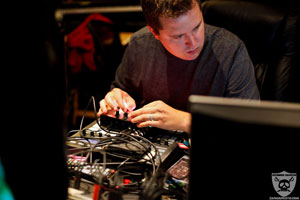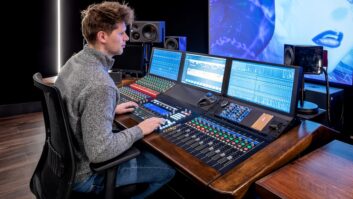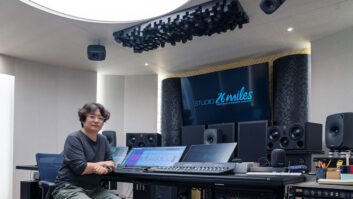
For the March 2011 column, I had the opportunity to interview Los Angeles–based producer/engineer/mixer Andrew Dawson (see “An Interview with Grammy Award–Winning Mixer/Engineer/Producer Andrew Dawson”), who at the time was a two-time Grammy Award winner. A little over a year later, he’s added a third statue to his mantle. And with the way 2012 has started off for Dawson, it would be no surprise if he has to do some re-arranging in the near future.
This month, I talk with Dawson about his latest projects, his formula for success, and some of the trends he’s seeing in the industry.
ANOTHER CHANCE FOR GROWTH
What are the qualities that make a producer/engineer desirable? It’s hard to pinpoint, but whatever they are, Andrew Dawson has them. With back to back album projects on his calendar that spill over into 2013, Dawson is indeed at the top of his game. And it’s not only because his dance card is full, but also because the projects with which he’s involved are yielding great success. Take, for instance, Fun’s hit song, “We Are Young”, a song that Dawson engineered. Not only was the song covered on the hit TV show, Glee, but it topped Billboard’s Top 100 Chart for more than six weeks and was featured in a Chevrolet ad that aired during the Super Bowl. In fact, the song was certified Platinum five times. Not a shabby way to start off the new year.
On the heels of the “We Are Young” project, Dawson worked with bands like indie group Pop Etc., hip-hop artist P.O.S., and Britain’s electronic dance duo, the Pet Shop Boys, the popular ’80s band famous for their hit song, “West End Girls.” Dawson was called upon to produce and engineer the duo’s newest album, which will be released on September 11.
“Neil [Tennant] and Chris [Lowe] were absolutely great to work with, and we had a lot of fun,” Dawson says. “The challenge was that we only had three months to do the project, which is pretty fast turnaround time for a major album, especially considering we had string dates and multiple musicians to work with.”
Producing strings for the Pet Shop Boys project was one of the biggest tests Dawson faced, and also one of his favorite experiences, an opportunity for tremendous growth. “I’ve recorded strings before, but on this project, I was not just the mixer, but the arranger,” Dawson says. “That meant I had to make sure that every note that was being played by the 25-member orchestra was absolutely spot on. There were probably a good couple of weeks that I barely slept at all, but it all culminated in a really exciting 7-hour session at Capitol [Studios] that I will never forget.”
FORMULA FOR SUCCESS
When Dawson is in “album mode,” he works every day of the week, and typically 14- to 16-hour days. “I definitely work way too much, but when I’m on this type of schedule, I try to take a week off once a month just to fit in a little bit of rest,” says Dawson.
Of course, it all depends on the demands of the project, which range from having to write songs from scratch to polishing up songs that are already written. For instance, P.O.S. came to the studio with some initial ideas to get the ball rolling, but the songs needed to be fully developed. On the other hand, Neil Tennant and Chris Lowe of the Pet Shop Boys came to the studio with roughly 30 songs in various stages of completion.
Andrew Dawson is pictured in The Record Plant’s Studio Suite SSL III in Los Angeles, while mixing Lil Wayne.
“My job was to work with [Lowe and Tennant] to pick out the [songs] that I thought deserved further development and would be most successful,” says Dawson. He narrowed the choices down to 19 songs before diving into arrangements. “Once we got to that point, there were obvious ones that stood out, plus a few songs that surprised us. In the end, it all came together really well, and we were able to narrow the songs down to the ones that were the true standouts.”
In a perfect world, Dawson would work on one album project at a time, but that isn’t always how things pan out. “It is a little challenging to take on more than one album at a time, simply because of the commitment you’ve got to give to each project,” he says, “but sometimes it just happens that way, and you have to make it work.” Dawson says that this scenario tends to work out best if he’s finishing one album and it enters into the mastering stage while the other project is beginning.
If he is juggling more than one project at a time and they happen to represent different genres, which is often the case, the good news is, Dawson does not have a problem making the mental transition. “It’s not difficult for me to work in more than one genre at a time,” he says. “I can separate styles pretty easily. I always have a vision for each song—whether it’s rock, pop, or hip-hop—and I know where I want to go with a song and have a clear idea of what’s in my head before I do any of the work on it.”
TAKING ADVANTAGE OF TRENDS
Dawson also has a knack for making the most of every situation, even ones that may otherwise be considered detriments to other producers. For instance, the DIY craze drives many producers over the edge, but Dawson has found a way to use it to his advantage. “It isn’t necessary for me to do every single thing on a record, so if a band member has Pro Tools and wants to record synth sounds, for instance, I tell him to go for it. Oftentimes it helps to divide and conquer in big projects, so if it saves me from sitting in front of the console for six hours trying to pick the right sound. It’s great.”
Another trend that Dawson is seeing is the rebirth of distortion. While this technique is becoming more and more popular and can be interesting when used properly in modern production, when overused, it can go too far and hinder rather than help a project. That said, Dawson is cautious about using it too copiously.
Dawson says he can’t live without his assortment of Universal Audio equipment and plug-ins, as well as his Lucas CS-4 and Peluso 2251 microphones. “I have had a lot of luck with these microphones,” he says. “The Peluso was used on the Fun record, and it worked amazingly well.”
Apparently, artists work amazingly well with Dawson, which is why he’s as busy as he is. “There are producers who are known for a signature sound, and that’s fine, but the thing is, not everyone wants that for their project,” says Dawson. “My focus is taking the ideas brought in by the artists, the songwriter, and other members of the team and bringing out the best in all of those elements. I try to listen intently to what the artist and team want so that I can understand their vision for the project and focus on their agenda rather than my own.”
He admits that he will argue hard for a point if he feels it’s going to benefit the project. “I have a responsibility to make the project as successful as it can be, but at the end of the day, it’s not my name on the record. I get to move on to another project, whereas the artist has to live with what is produced forever, so, ultimately, they have to be happy with it.”
Lisa Horan is a writer with more than 19 years of industry experience, as well as the co-founder and executive director of PopMark Media, a unique partnership that offers creative and marketing, custom music and music production, and audio post-production services to music, film, and business clients. Her “Confessions of a Small Working Studio” column has been regularly featured in Mix since 2010.







